Two years ago I made green tea and black bean cake using the left-over "kuromame" 黒豆 black beans in syrup that came in the Sushi Taro osechi box. The recipe I used is in English in our blog. This year I commissioned my wife to take over making the green tea cake. Then, she pointed out that we were out of "matcha" 抹茶 green tea powder. I kept it in the freezer and mostly used it for cooking such as making "green tea salt" for tempura and apparently didn’t replace it after using it up. Since we are not physically going to our Japanese grocery store because of covid, I decided to get the green tea on line. Hibiki-an 響庵 is a company we have used in the past to get green tea and we could have gotten matcha from them but it is shipped directly from Japan and would have taken too long to get here. I then found "Matcha Kari" which imports its matcha stock from Japan but is located here so delivery time was much shorter. I bought a mid-priced tea from them called "First harvest sipping matcha". (According to Mach-kari’s, Hibiki-an’s, and other websites which sell matcha, they offer several grades of matcha which appear to range from lowest quality/lowest price to highest quality/highest price, identified as “culinary”, “sipping”, “ceremonial” and “competition”.) (Disclaimer: I am not sure if there is official grading of matcha and if so what the grades would be). While we were waiting for this to arrive, I happened to see, while picking up a take-out at Tako Grill, that they had the matcha tea brand we used to get from our Japanese grocery store. This was very reasonably priced ($0.28 per gram, while the one from Matcha Kari was $1.17 per gram or over 4 times more expensive). I assume that the one from Tako Grill was not as low-grade as “culinary” matcha according to the lexicon I outlined but would be at the lower end of “sipping“ grade. It also came from “Uji” 宇治 near Kyoto 京都. We have gotten regular Uji green tea (sencha 煎茶) from Hibiki-an in the past and it was pretty good. So as far as I was concerned this matcha (left in the picture below) was certainly good enough to make green tea cake. Then, a few days later we received the matcha from "matcha kari".
Showing posts sorted by relevance for query bamboo. Sort by date Show all posts
Showing posts sorted by relevance for query bamboo. Sort by date Show all posts
Sunday, January 31, 2021
Matcha green tea tasting 抹茶の飲み比べ
I made the two kinds of matcha, (the one from Tako Grill shown on the left and the one from Macha kari shown on the right) and taste tested.
For the sweet “chagashi” 茶菓子 accompanying the matcha I served the last of the “kurt-kenton” 栗きんとん the mashed sweet potato with chestnuts from the Sushitaro osechi box and green plum I made simmered in syrup 小梅の甘露煮. It is customary to serve such a sweet with matcha to enhance the flavor of the tea.
First of all, as a disclaimer, we have to acknowledge that we are not connoisseurs of matcha. Nonetheless after carefully sniffing and tasting both matcha we could state, with confidence, that despite quite a difference in price, we could not identify any difference in taste; none. The first thing that came to mind was the Japanese expression “Giving gold coins to a cat” or “neko ni koban 猫に小判” i.e. giving something of value where it can’t be appreciated. Well we did say we weren’t connoisseurs and this may just prove it. In the future, however, we will stick to the more reasonably priced macha.
Monday, July 1, 2013
Grilled Pork belly "Kakuni" 豚の角煮焼き
Whenever we go to our near-by gourmet grocery store, I cannot resist buying a block of pork belly. The last time was not an exception and I made the usual "kakuni" 豚の角煮. We restricted the servings to one small piece at a time. I decided to vary how I served it.

Recently, I found out that there were two cookbooks on Izakaya cuisine in English and bought them. One is called “Izakaya Japanese barfood” and the other is called ”Izakaya Hawaii, Tokkuritei cooking”. I am planning to post them on the Izakaya cookbook section of this blog soon ("soon" could mean in several months). Flipping over the pages of these cookbooks, I saw a crispy grilled pork belly dish in which the meat was first braised in liquid and then grilled. Since I already had "kakuni" made up, I decided to grill it.
After I warmed up the kauni in the broth I grilled it in the toaster oven (on broil). For the sake of convenience, I skewered one piece of pork belly with two bamboo skewers so that I could easily turn over to cook the other side. I covered the pre-soaked bamboo skewers and also the exposed parts of the skewers with pieces of aluminum foil. Upon reflection I could have just grilled the meat and put the skewers on later. Oh, well.

In any case, this method adds a crunchy crust to this fatty pork. This is definitely worthwhile variation of pork belly "kakuni".

Recently, I found out that there were two cookbooks on Izakaya cuisine in English and bought them. One is called “Izakaya Japanese barfood” and the other is called ”Izakaya Hawaii, Tokkuritei cooking”. I am planning to post them on the Izakaya cookbook section of this blog soon ("soon" could mean in several months). Flipping over the pages of these cookbooks, I saw a crispy grilled pork belly dish in which the meat was first braised in liquid and then grilled. Since I already had "kakuni" made up, I decided to grill it.
After I warmed up the kauni in the broth I grilled it in the toaster oven (on broil). For the sake of convenience, I skewered one piece of pork belly with two bamboo skewers so that I could easily turn over to cook the other side. I covered the pre-soaked bamboo skewers and also the exposed parts of the skewers with pieces of aluminum foil. Upon reflection I could have just grilled the meat and put the skewers on later. Oh, well.

In any case, this method adds a crunchy crust to this fatty pork. This is definitely worthwhile variation of pork belly "kakuni".
Saturday, August 28, 2010
Making tekkamaki and uni sushi at home 鉄火巻きと雲丹の軍艦巻き
Since we received the shipment of tuna and uni from Catalina, we are "pushing" these items on our menu--lunch and dinner. We gave some serious thought to breakfast but decided to draw the line somewhere. I made this as lunch over the weekend.

I put enough uni on the gunkan-maki base to cover the rice (generously).
At home, I usually make sushi rolls 巻き寿司 or scattered sushi "chirashi" ちらし寿司 but not "nigiri" 握り寿司 which requires the skill that I do not have. Among the sushi rolls, one is called futomaki 太巻き. I actually make a deluxe (?) version which our sushi chef, Hajime, at the long-defunct Japanese restaurant, Mikado, showed me how to make many years ago. This deluxe version uses two nori sheets with both uramaki 裏巻き (the rice layer facing outside) and omotemaki 表巻き (the rice layer inside and the nori outside) combined into one roll. I am sure I will post it sometime in the future. Another roll I make often is California roll since it is uramaki, it is easier to make (it will not come apart easily like a regular hosomaki 細巻き and the ingredients are readily available at any time in the U.S.- avocado and crab meat.
This time I made a classic Tekka roll 鉄火巻き using an akami 赤身 portion of the tuna and "Uni no gunkan-maki" 雲丹の軍艦巻き.
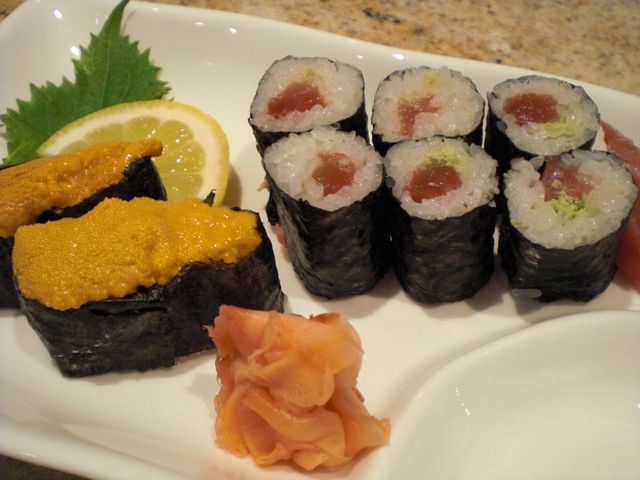
First, I make sushi rice. Since my wife (and myself) like a good vinegar flavor, I add as much sushi vinegar (from the bottle, but one which contains real rice vinegar such as Mizkan ミツカン brand ) as the rice can absorb.
Next, I make the base for the Uni sushi called "Gunkan-maki" 軍艦巻き, "gunkan" means a miitary ship since it resembles the hull of a naval vessel (see the flotilla in the lower left image). I just make a small oval shaped rice ball and then wrap a nori sheet (cut 1/2 along the long axis to make a half-width nori sheet and then cut long strips with 1/3 of the width of the half sheet). I use a rice kernel to secure the end of the nori strip to make the nori-rice container as in the lower left image (another technique I learned from Hajime the sushi chef). The lower right is a tray of uni from Catalina.
To make the tuna tekka maki, I cut a long rectangle of akami of tuna for tekka maki. I put a small amount of real wasabi on a small plate.

I cut a full sheet of nori 海苔 in half and place in on the bamboo sushi mat or makisu 巻き簾 (lower left) and spread the sushi rice in a thin layer and smear wasabi along the mid-line. I make sure to leave a 1/2 inch of nori at the far end uncovered, otherwise, the roll will not close or stay closed. To prevent the rice from sticking to my hands, I use cold water with a dash of vinegar in it to moisten my hand. I shake off or wipe off excess moisture from my hands using a tea towel just before touching the rice every time. This keeps my hands cold and prevents the rice from sticking.
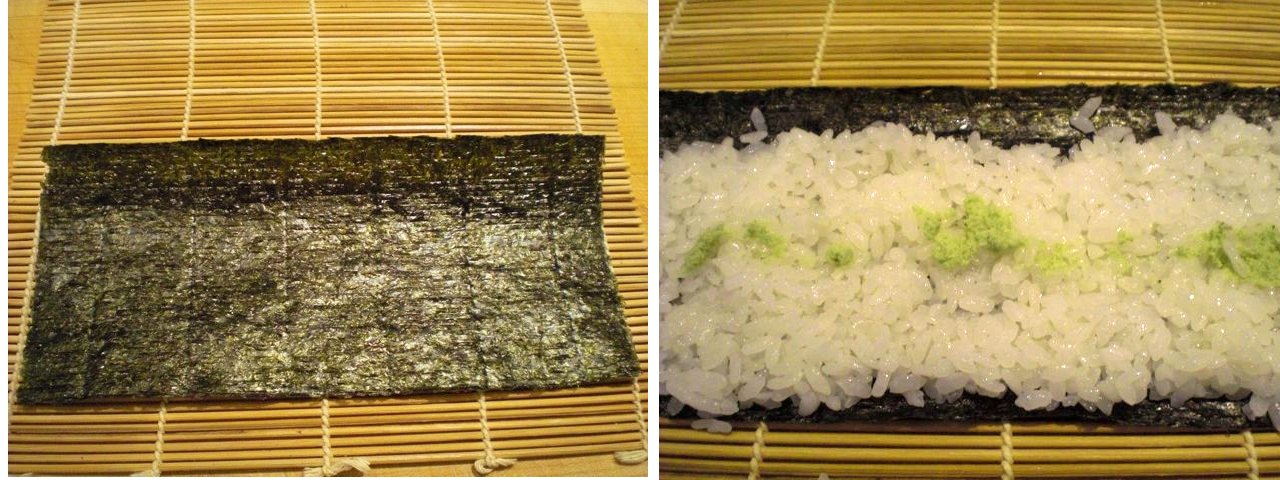

 This was lunch but we had a one small glass of cold sake. (The taste of vinegared rice demands the accompanying taste of sake). It may not look as pretty as the ones prepared by a pro but this tasted very good. Certainly 100% better than any box of sushi bought at the grocer store.
This was lunch but we had a one small glass of cold sake. (The taste of vinegared rice demands the accompanying taste of sake). It may not look as pretty as the ones prepared by a pro but this tasted very good. Certainly 100% better than any box of sushi bought at the grocer store.
I place the rectangles of akami on top of the stripe of smeared wasabi. Since I took these pictures myself, I cannot show how I made the roll more precisely using pictures. Here goes a verbal description: with the edge of nori covered in rice close to me, while holding the tuna with my index fingers in the middle of the roll, I aim the rice covered edge to meet the far edge of the rice layer. I then pull back slightly so the two rice edges make good contact. Then I roll forward again so the nori tab covers the rice seam. (This step is what assures that the pieces of the roll hold together after they are cut). Once the seal has been made, I squeeze the bamboo mat to form the roll.
Anyway here is the end result. The rice should not come out at the bottom seam and the nori should wrap all around. After making two rolls I used a thin bladed sharp knife, put the rolls next to each other and cut both rolls simultaneously. (I do not have a Japanese yanagi-ba 柳刃 so I use a long "Swedish" fillet knife from Global - for slicing smoke salmon, I suppose - but works very well). I dip the blade into the water vinegar mixture and shake off the excess water before slicing the rolls (all this is to prevent the rice from sticking to the blade of the knife). Imitating a sushi chef, I cut the rolls in half first and then cut the each half into thirds.
Saturday, May 1, 2010
Spooned tofu with "jako" and Jalapeno pepper 掬い豆腐のじゃことハロペニョペッパーかけ
Tofu 豆腐 has become a very popular food in the U.S. but what we get as tofu in our grocery store is far from the good tofu you can enjoy in Japan. As I mentioned before some good Japanese companies are producing decent tofu in the U.S., but it is not always easy to get quality tofu. There is a category of tofu which is not pressed to remove excess water. As a result, the tofu is softer and has a more silky texture. These are often called "spooned tofu" or "sukui tofu" 掬い豆腐 or if the tofu is only drained using a a Japanese bamboo basket called "zaru", it is called "zaru-age tofu" ざる揚げ豆腐 (Although, in the factory, I am sure they do not use a bamboo basket.). Actualy, Tako Grill does serve this type of home-made tofu. It is usually eaten with a bit of salt (Tako grill serves with pink - ume or plum flavored- and green -green tea flavored- salts). You could buy this type of very soft tofu in a small plastic container in a Japanese grocery store as well. The tofu I used here is soft silken tofu from Kyo-zen-an 京禅庵. Since it was very soft (softer than usual), I scooped up soft silken tofu using a spoon and served it as "spooned tofu".
* Among the "frikake", Japanese rice seasonings, one made from red perilla which was a by-product of making Umeboshi can be dried or semi dried to make umeboshi flavoured frikake called "yukari". The one I used is semi-dried yukari which also contains small chunks of crispy pickled (but not dried) plum.
Saturday, September 22, 2018
Smoked salmon and salmon salad roll スモークサーモンとサーモンサラダ巻き
My wife is a firm believer that mayonnaise and sushi rice are a good combo. We tried her theory previously with tuna hand rolls and "Salmon salad" sushi. We regularly prepare grilled salted salmon with crispy skin (after salted and dried for few days in the refrigerator) We finish the skin but we make leftover salmon meat. I often make the leftover salmon into salmon salad by flaking it and dressing it in a mixture of Greek yogurt and mayonnaise. We enjoy the salmon salad as an appetizer as a canapé by putting it on the cracker. Since we had still some salmon salad left, my wife suggested this salmon salad roll with smoked salmon and caper. I took her suggestion and I made a medium sized roll or "chu-maki" 中巻き (As opposed to Futomaki 太巻き fat roll or Hosomaki 細巻き thin roll). This differed from our previous post because it is a roll and includes smoked salmon
I made the salmon salad a few days earlier. I used a mixture of Greek yogurt, mayo, Dijon mustard seasoned with Myer lemon juice, fresh dill, salt and pepper. to dress the flaked grilled salmon.
The rice was distributed a bit unevenly.
Since this was a weekday evening, I took a short cut and used frozen rice to make the sushi rice. I have a Japanese container we got at our grocery store which was designed to store cooked rice frozen. The lid has either small air vent or by turning the lid 180 degree, the lid will leave small gap so that microwaving the frozen rice will steam the rice. I also microwaved sushi vinegar (from the bottle) to warm it up and dressed the warm rice and let sit for 5 minutes.
Ingredients:
Sushi rice, 1 cup (see above)
Nori dried seaweed sheet, one
Smoked salmon, 3 slices or enough to cover the rice
Salmon salad, enough to spread to cover the rice
Caper, 20 buds
Directions:
Place the nori sheet on the bamboo sushi mat
Spread the sushi rice in a thin layer on the nori to cover about 70% (for a medium roll)
Place one layer of the smoked salmon
Spread the salmon salad and top it with capers (see below)
Roll it with the bamboo mat and press to shape.
Wet the blade of a knife and slice the roll in half and then slice each half into 5 slices each.
This again proves my wife's theory that mayo and sushi rice go well together. The only problem with this iteration was that the salmon salad was a bit on the wet side with Greek yogurt and Mayer lemon juice but it tasted great. Sushi rice from frozen rice was not bad at all and this was a great ending dish for the evening.
I made the salmon salad a few days earlier. I used a mixture of Greek yogurt, mayo, Dijon mustard seasoned with Myer lemon juice, fresh dill, salt and pepper. to dress the flaked grilled salmon.
The rice was distributed a bit unevenly.
Since this was a weekday evening, I took a short cut and used frozen rice to make the sushi rice. I have a Japanese container we got at our grocery store which was designed to store cooked rice frozen. The lid has either small air vent or by turning the lid 180 degree, the lid will leave small gap so that microwaving the frozen rice will steam the rice. I also microwaved sushi vinegar (from the bottle) to warm it up and dressed the warm rice and let sit for 5 minutes.
Ingredients:
Sushi rice, 1 cup (see above)
Nori dried seaweed sheet, one
Smoked salmon, 3 slices or enough to cover the rice
Salmon salad, enough to spread to cover the rice
Caper, 20 buds
Directions:
Place the nori sheet on the bamboo sushi mat
Spread the sushi rice in a thin layer on the nori to cover about 70% (for a medium roll)
Place one layer of the smoked salmon
Spread the salmon salad and top it with capers (see below)
Roll it with the bamboo mat and press to shape.
Wet the blade of a knife and slice the roll in half and then slice each half into 5 slices each.
This again proves my wife's theory that mayo and sushi rice go well together. The only problem with this iteration was that the salmon salad was a bit on the wet side with Greek yogurt and Mayer lemon juice but it tasted great. Sushi rice from frozen rice was not bad at all and this was a great ending dish for the evening.
Saturday, July 28, 2012
Cold thin udon noodles with dipping sauce 冷たいうどん
We are having some very hot and humid days including a sudden big storm called a (derecho). The storm was incredibly violent. Large trees with trunks several feet in diameter were split in half by the high winds. This happened to a number of trees around us. All of the debris from the downed trees ended up in our neighbors yard but luckily they did not cause any significant structural damage. In addition we lost our power for just a short period of time. In our area, many other people were not so fortunate. Eleven people lost their lives due to the storm. In addition, many households went without electricity for almost a week in temperatures hovering around 100 F. One evening, I made a cool and easy to eat dish for the hot humid summer evening.

Initially, I thought I would like to make "soumen" 素麺 but I found out that I was totally out of it. The reason, I remembered, was that I threw away all the dried soumen I had few month ago. "Soumen" has a coat of oil on the surface in the process of making noodles very thin without sticking together. The oil will eventually oxidize. So, soumen does not last as long as other dried noodles. I looked around and found I had some very thin dried udon which was perfect for eating cold with dipping sauce. This one is called "Harima's thread udon" 播磨の糸うどん (see below left). I have to assume it came from Hyogo prefecture 兵庫県 area where the noodles, especially soumen, are one of their well-known local food items.
 Udon noodles: I followed the package instruction and boiled the udon noodles for 8 minutes in rapidly boiling water (no salt) and then quickly rinsed in cold running water. I added ice cubes on top while it was in the colander to cool it down completely.
Udon noodles: I followed the package instruction and boiled the udon noodles for 8 minutes in rapidly boiling water (no salt) and then quickly rinsed in cold running water. I added ice cubes on top while it was in the colander to cool it down completely.
Condiments: This could be as Spartan as just chopped scallion to anything you like. I went for a rather deluxe (sounds dated) version and included the followings:
1. Chicken breast: This is the leftover barbecued chicken breast which was teased into thin strands.
2. Cucumber: One mini-cucumber was sliced on a slant and then julienned.
3. Golden thread omelet: "Kinshiran" 金糸卵 from one egg.
4. Scallion: Two, finely chopped.
5. Nori: This is one package of seasoned nori cut into thin strips.
Dipping sauce: I used a bottle of concentrated noodle sauce. According to the instructions on the bottle label, I diluted it to 1 part sauce and 2 parts water. I tasted it. It was slightly less potent than I would have used for dipping sauce but I felt it was fine.
Dipping sauce: I used a bottle of concentrated noodle sauce. According to the instructions on the bottle label, I diluted it to 1 part sauce and 2 parts water. I tasted it. It was slightly less potent than I would have used for dipping sauce but I felt it was fine.

I could have placed the udon on a small serving bamboo basket which is called "zaru" ざる in Japanese (which I have and, if I did use it, this dish could have been officially called "zaru udon" ざるうどん (I did serve cold udon a few days later in a special serving dish with a bamboo mat on the bottom which qualifies this dish as "zaru udon" -see picture below- but, instead, I served these noodles in a rather cool looking square shallow glass bowl (see above picture). I topped the cold udon with slices of pickled okra and cherry*. Since I did not have perilla, I julienned fresh basil leaves and pretended it was perilla.
*Cherry: This is how my wife prepares cherry. She removes the stone or pit using a handy-dandy cherry pitter. She then cuts the pitted cherry in half to make sure no pits were left behind by the pitter (biting into an unsuspected pit is extremely unpleasant not to mention lethal to teeth). Then she marinates the cherries in a small amount of triple sac. This tends to preserve the fruit making it last longer while still retaining its fresh flavor and texture. We used this as our fruit with lunch etc.

The above picture is the "zaru udon" I served on a different day. This time, the green strip (2nd from the top) was indeed a julienne of perilla and the white strip (top) was Vidalia onion (salted, kneaded and briefly soaked in cold water) instead of scallion. The 3rd strip was sake-steamed chicken, the 4th threads of omelet, and the last cucumber. The condiments were for two of us.

The above picture is the "zaru udon" I served on a different day. This time, the green strip (2nd from the top) was indeed a julienne of perilla and the white strip (top) was Vidalia onion (salted, kneaded and briefly soaked in cold water) instead of scallion. The 3rd strip was sake-steamed chicken, the 4th threads of omelet, and the last cucumber. The condiments were for two of us.
Back to the Udon dish: When I served the dish I of course, placed a bottle of Japanese 7 flavored red pepper fakes 七味唐辛子 on the same tray to add a little kick (mostly for me). This was a perfect cold dish to finish. We liked this thin udon much better than soumen. It has a nice al dente texture and is nicely smooth as it comes into the mouth. All the condiments made this noodle dish a full-fledged meal.
Saturday, August 7, 2010
Grilled egg plant 焼き茄子
In Japan, you can get such nice and fresh vegetables, including cucumbers and eggplants, much more easily than in the U.S.. There are several kinds of Japanese eggplants; some can be even eaten raw ("water eggplant" or "Mizunasu" 水茄子). I like "Kamonasu" 賀茂茄子, famous for being used in Kyoto cuisines. You can not get these easily in the U.S.. The kind of eggplants we can get here are limited to mostly Western varieties. Occasionally, what they call a "Japanese" eggplant is available (a light purple and small elongated kind) but I do not recall seeing similar eggplants in Japan. I tend to use small Italian eggplant and Zebra eggplant for my Japanese style cooking but, sometimes, it does not work out. Simply grilled Japanese eggplant, "yakinasu" 焼き茄子 is wonderful if the eggplant is good. I found a small (baby) Italian eggplant which looked very good but bought only one, because the last time I tried to make this from Italian eggplants, it was pretty bad. I am sure, because I only got one this time, it turned out pretty good and I wish I had bought more.

Before grilling, I just prick the skin of the eggplant all over with the tines of a fork or a tip of a bamboo skewer to prevent from the eggplant from exploding (This happened once in our Weber grill. We heard a big "bong" noise. A small puff of ash came out the bottom vents of the grill. Upon investigation we found the meat of the eggplant spread all over the inside of the lid. Nothing was left on the grill except for few fragments of the charred skin.) After 15 minutes or so, the eggplant is thoroughly cooked (turn several times during the cooking) and soft as seen below. Make sure the eggplant is completely cooked. Using chopsticks or tongs, peel off the skin holding the cap while it is hot. Using a small knife or a bamboo skewer, cut the eggplant along the long axis (you can plant the skewer in the meat near the cap and then grab the cap and pull the skewer through). repeat this a few times to make long strands of eggplant. Cut at the cap but I keep the cap for presentation. I garnish with dried bonito flakes and chiffonade of perilla. As a seasoning, I can use just soy sauce but I happened to make my dipping sauce for other dishes we had (dashi 2 parts, mirin 1 part and soy sauce 2 parts) so I used my dipping sauce.
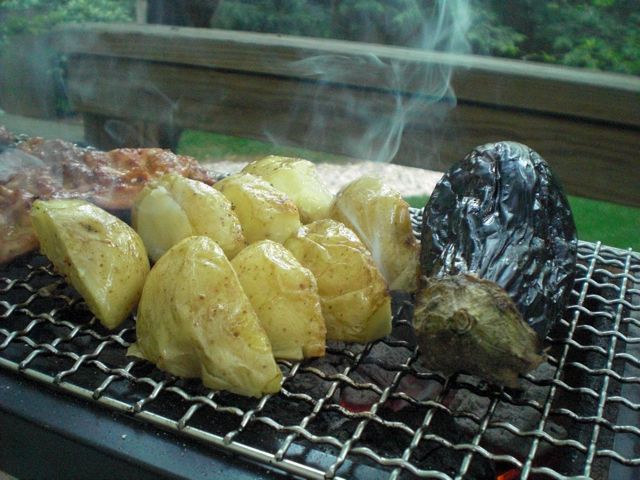
Eggplant is almost done along side potatoes which are being grilled for "Jagabata" or potato with butter.
Friday, February 14, 2014
New Year's eve soba noodle from Sushi Taro Osechi 寿司太郎の年越しそば
This should have been posted earlier but somehow got delayed. New year's eve soba noodles or "Tosh-koshi soba"年越しそば appears to be a common custom in Japan (with about 57% of the population participating according to Japanese Wikipedia). When I was growing up, however, our household did not have this custom at all. We usually had a feast on New Year's eve that did not leave any room to eat soba even if we wanted to. It appears that the custom started in Edo period 江戸時代 for good luck/longevity (longevity because soba is thin and "long" and to "cut" bad fortune from the previous year as soba is brittle and easily can be cut). In any case, Sushi Taro Osechi also included hand cut or "teuchi" 手打ち "Toshikoshi soba". We were too full to eat this on the New Year's eve but we ate this as a lunch on the second day of the New Year.

There appears to be many variations of toshikoshi soba (cold or hot in a broth etc), I made it to "zarusoba" ざるそば as you see above. ("Zaru" means "bamboo basket" as the noodles are served a special flat bamboo basket or in a special container like I used).
The Sushitaro soba came in a separate box with instructions. According to Chef Kitayama's description, it was made from specific soba and wheat flours produced in Hokkaido. A pieces of kelp and "Katsuobush" 鰹節 dried bonito flakes (real "MaCoy", probably shaving from the ends of the dried bonito or katsuobushi were included and were perfect to make dashi). I followed the instructions and prepared the soba and dipping sauce. For garnish, I served thinly sliced scallion and nori strips. I also added Japanese red pepper flakes ("Ichimi tougarashi" 一味唐辛子)

The noodles had a nice al-dente texture and we enjoyed it although it was not the "end-of-the-year" but "beginning-of-the-year" soba.

There appears to be many variations of toshikoshi soba (cold or hot in a broth etc), I made it to "zarusoba" ざるそば as you see above. ("Zaru" means "bamboo basket" as the noodles are served a special flat bamboo basket or in a special container like I used).
The Sushitaro soba came in a separate box with instructions. According to Chef Kitayama's description, it was made from specific soba and wheat flours produced in Hokkaido. A pieces of kelp and "Katsuobush" 鰹節 dried bonito flakes (real "MaCoy", probably shaving from the ends of the dried bonito or katsuobushi were included and were perfect to make dashi). I followed the instructions and prepared the soba and dipping sauce. For garnish, I served thinly sliced scallion and nori strips. I also added Japanese red pepper flakes ("Ichimi tougarashi" 一味唐辛子)

The noodles had a nice al-dente texture and we enjoyed it although it was not the "end-of-the-year" but "beginning-of-the-year" soba.
Saturday, April 16, 2011
Flavored rice with chicken 鶏ご飯
When I posted Chicken rice 鶏飯, I mentioned that if "鶏飯" is pronounced as "tori-meshi" とりめし instead of "keihan" けいはん, it means an all together different dish, which is the dish I am posting here. "Cooked rice" in a polite form in Japanese is "gohan" ご飯, so you could also call this dish, more politely, "Tori-gohan" 鶏ご飯. This is a flavored rice with pieces of chicken. There are many variations and the size and the amount of chicken in this dish also varies. This is my rendition.
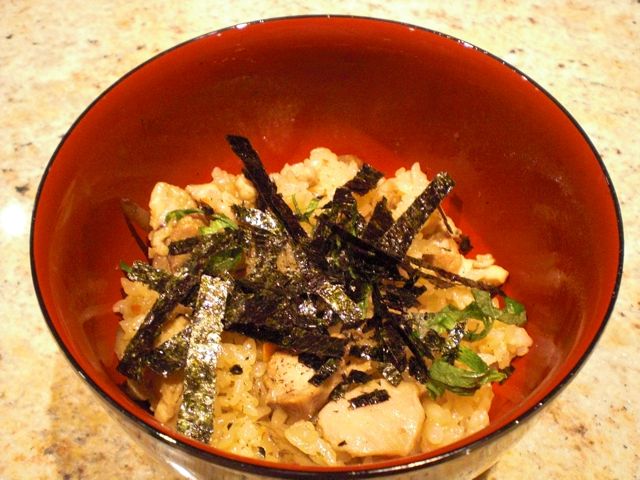
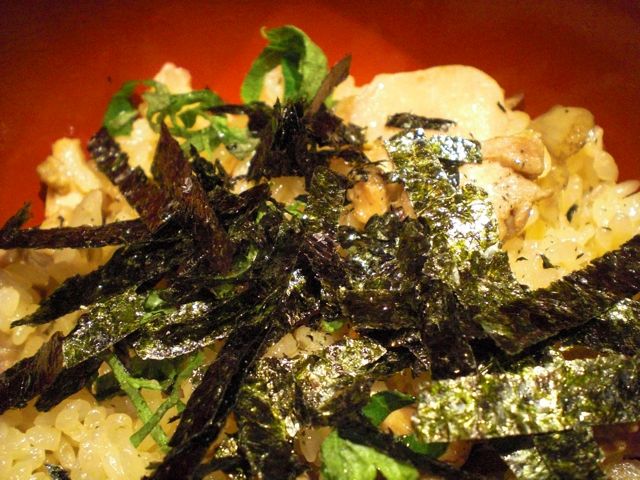
The amount below is for 3 cups (Japanese cup, which is about 180ml, ones come with a Japanese rice cooker) of raw rice which serves 4-6 people (or 10 of us).
Seasoning: I added vegetable oil (1 tbs) in a frying pan on medium heat and first cooked the chicken. When the surface of the chicken became opaque, I added the burdock and carrot and sauteed them for 1-2 minutes. I then added sake (3 tbs), mirin (2 tbs) and soy sauce (2 tbs) and cooked for 1 minute or so. Using a colander or strainer, I separated the solids from the liquid (preserving both separately).
Cooking: This time I used an electric rice cooker but I could have used a Donabe rice cooker. To set up the rice cooker, I added the washed and drained rice and then added the seasoning liquid reserved from cooking the chicken and other ingredients. I then brought the liquid level up to the 3 cup mark by adding dashi broth (or water). I added the chicken and vegetables and stirred it once or twice. I then cooked it like regular rice. After it finished cooking I let it steep for 10-15 minutes (see picture below). With a rice paddle, I stirred the rice and other items (in Japanese culinary parlance, these are called "gu" 具).
Serving: You usually want to add some greens to this dish. Cooked green beans cut into small segments, green pea, snow pea or snap pea can be added as a garnish. In my case, I added a chiffonade of perilla and nori.
Chicken: I used two thighs, bone and skin removed, and cut into small chunks (half inch).
Vegetables: I used ginger root (one thin sliver, skin removed and minced), gobo 牛蒡 or burdock root (1/2), and carrot (1 small). For gobo, after scraping off the dark skin of the gobo using the back of the knife under running water, I cut it into small, thin, "small bamboo leaf shape" which is called "sasagaki" 笹掻き cutting ("sasa" 笹 is a type of small bamboo). This is a very common way to cut root vegetables, especially gobo. You do this by shaving the end of burdock like you are sharpening a pencil (I am not sure how many of you actually shaved and sharpened a lead pencil encapsulated in wood cylinder, i.e. an old fashioned pencil, using a knife). Here is a visual aid for "sasagaki". I put the sasagaki cut burdock in acidulated water (with rice vinegar) immediately. I changed the water several times and let it drain (to reduce the pungent smell/taste and prevent discoloration). I also cut a carrot (one small) in the same way as the gobo. If you like, you could add, a deep fried tofu pouch (abura-age), shiitake mushroom, and/or lotus root (renkon 蓮根); all cut into small pieces.
Vegetables: I used ginger root (one thin sliver, skin removed and minced), gobo 牛蒡 or burdock root (1/2), and carrot (1 small). For gobo, after scraping off the dark skin of the gobo using the back of the knife under running water, I cut it into small, thin, "small bamboo leaf shape" which is called "sasagaki" 笹掻き cutting ("sasa" 笹 is a type of small bamboo). This is a very common way to cut root vegetables, especially gobo. You do this by shaving the end of burdock like you are sharpening a pencil (I am not sure how many of you actually shaved and sharpened a lead pencil encapsulated in wood cylinder, i.e. an old fashioned pencil, using a knife). Here is a visual aid for "sasagaki". I put the sasagaki cut burdock in acidulated water (with rice vinegar) immediately. I changed the water several times and let it drain (to reduce the pungent smell/taste and prevent discoloration). I also cut a carrot (one small) in the same way as the gobo. If you like, you could add, a deep fried tofu pouch (abura-age), shiitake mushroom, and/or lotus root (renkon 蓮根); all cut into small pieces.
Seasoning: I added vegetable oil (1 tbs) in a frying pan on medium heat and first cooked the chicken. When the surface of the chicken became opaque, I added the burdock and carrot and sauteed them for 1-2 minutes. I then added sake (3 tbs), mirin (2 tbs) and soy sauce (2 tbs) and cooked for 1 minute or so. Using a colander or strainer, I separated the solids from the liquid (preserving both separately).
Rice: You could use a just regular Japanese rice but I added sweet rice or glutenous rice. Japanese will call this rice "mochi-gome" 餅米* since rice cakes or mochi 餅 is made from this variety of rice. I used a mixture of regular rice (2 Japanese cups) and sweet rice (1 Japanese cup). This adds a stickier texture to the cooked rice but this is optional. I washed the rice under running cold water until the water ran clear. I then drained and let it sit in the strainer.
*(Digression alert) Mochi-gome contains mostly amylopectin as a type of starch, which gives it a stickier consistency than regular Japanese rice. It can be easily distinguished from a regular Japanese rice since the germ of mochi-gome is opaque. As a result, after washing, the rice grains look white and opaque rather than slightly transparent like regular rice. Some rice dishes, beside rice cake, can be made solely from mochi-gome, which are called "okowa" おこわ. Red rice or "sekihan" 赤飯 served on celebratory occasions in Japan is the example of "okowa".
Cooking: This time I used an electric rice cooker but I could have used a Donabe rice cooker. To set up the rice cooker, I added the washed and drained rice and then added the seasoning liquid reserved from cooking the chicken and other ingredients. I then brought the liquid level up to the 3 cup mark by adding dashi broth (or water). I added the chicken and vegetables and stirred it once or twice. I then cooked it like regular rice. After it finished cooking I let it steep for 10-15 minutes (see picture below). With a rice paddle, I stirred the rice and other items (in Japanese culinary parlance, these are called "gu" 具).
Serving: You usually want to add some greens to this dish. Cooked green beans cut into small segments, green pea, snow pea or snap pea can be added as a garnish. In my case, I added a chiffonade of perilla and nori.
This is a very nice and tasty dish. The addition of sweet rice gave it more body or a "mochi-mochi" もちもち texture, if I am allowed to use a Japanese expression. My wife thought she could not tell the difference from regular rice. This is a perfect "shime" 締め or ending dish or, by itself, with a salad or tsukemono 漬け物 and miso soup, this could be a whole meal.
Friday, April 18, 2014
Cherry blossom gazing part 2 続花見
We continued with our hanami. We have mentioned before that, for some reason, the birds (and now other creatures) eat the cherry blossoms from the trees in our backyard. These are ornamental rather than fruit producing cherry trees so we’re not clear why they do this. In addition, we have not heard of similar behavior toward the trees on the Tidal Basin or anywhere else for that matter. It started some time ago with the house finches. Then apparently the cardinals learned from the finches and we have a few pictures here as “proof”. Sometimes it feels like a race to finish our hanami before the birds finish the blossoms we are celebrating. Often the petals are raining down around us at a furious pace as we raise our sake glasses in libation (Occasionally having to pause and fish out petals that plop into the up-raised glasses.)
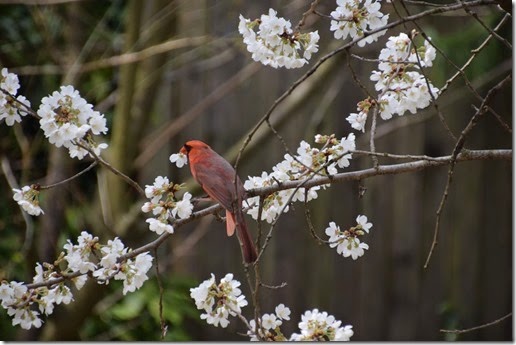
As you can see this one got caught “red beaked” as it were. Come to think of it their beaks are always red.
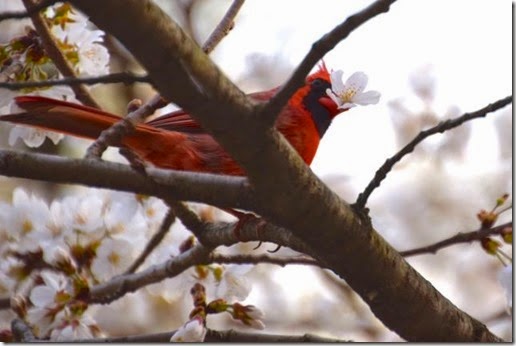
They only eat the bottom of the flowers which must contain a sweet nectar or something.

Amazingly, some of our squirrels appear to have learned from the birds. This is the first year we caught one eating the flower. As a result, even before full bloom, cherry petals were dropping.
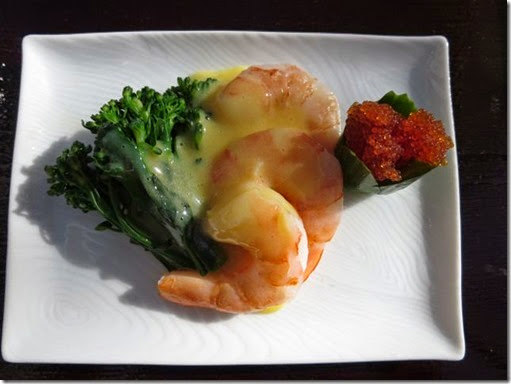
In any case, we continued with our feast despite this distraction. This one is "Nanohana" (broccolini) and shrimp dressed in “kimisu” 菜の花と海老の黄身酢和え. “Kimisu” is a sort of Japanese hollandaise sauce without butter. I also added cucumber cup with tobiko roe on the side.
I got this idea when Chef Kitayama of Sushi taro served a dish with “kimisu” the last time we dined there. His was very rich and thick. He said he attained that texture by freezing the eggs in the shell. This makes it easier to completely remove the egg white (after thawing I assume) and also removes extra moisture from the yolk. I, of course, did not take this extra-step. Here is my recipe (the standard recipe but I did not measure the ingredients, the below is my estimate).
“Kimisu” 黄身酢:
One egg yolk (I used pasteurized shell egg)
Sugar (1 tsp)
Salt (small pinch)
Sake and mirin (1 tsp each)
Rice vinegar (1 tsp)
I mixed everything in a small sauce pan, on the lowest flame. Using a silicon spatula, I continuously mixed until the sauce thickened. I moved the pan on and off the fire to prevent scrambling the eggs. Since I did not remove the chalaza completely from the yolk, it became white hard specks in the sauce. I used a fine mesh strainer to remove it. I placed it in a small sealable container and refrigerated until use.
“Nanohana” 菜の花: I have posted information about flowering rapeseed plants and possible substitutes in the U.S. The substitute is between broccolini and broccoli rabe. I used broccolini for this dish. I just blanched it in salted boiling water for a few minutes and shocked it in ice cold water and drained.
Shrimp: These were shell-on frozen shrimp. I thawed them under running water. I rather severely salted it and let it stand for a while. I then cooked them in gently simmering salted water splashed with sake for few minutes, let them cool in the shell and then peeled the shell.
Although the sauce was not as rich or thick as Chef Kitayama's it was rather luxurious with some tang and sweetness gently wrapped in. A perfect, subtle spring dish.
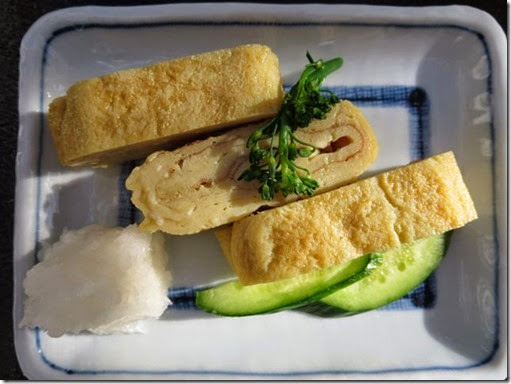
The 3rd dish was usual “dashi maki” 出し巻き Japanese omelet. I served it with grated daikon and soy sauce on the side.
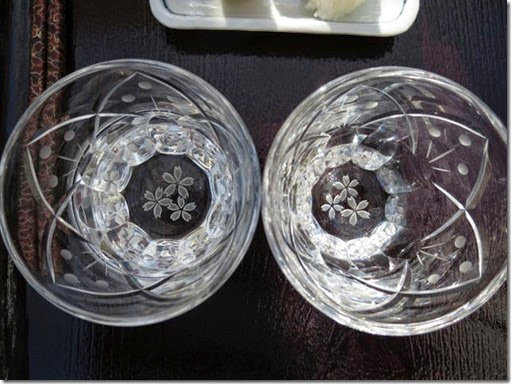
We switched the sake glasses . These came from Kitaichi glass 北一グラス in Otaru 小樽. Left is with sake in it, the right is without sake. Once the glass is filled with liquid, the cherry blossom pattern around the base appear to float up but it is not easy to capture this in a photograph. In any case, these were more appropriate glasses for the occasion.
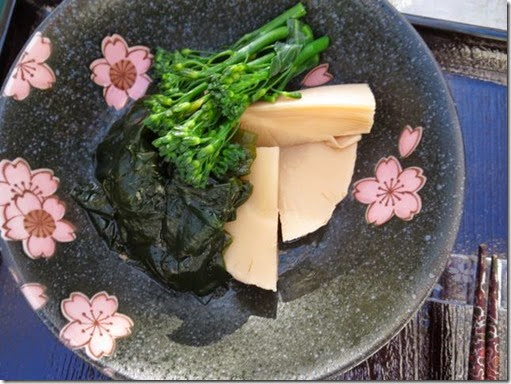
The 4th dish was Wakatake-ni 若竹煮. Although it is the season for bamboo shoots and fresh wakame seaweed in Japan, we could not get these seasonal items around here. I used packaged boiled bamboo shoot (I am sure from the last year crop) and salt preserved wakame sea weed (which was kept frozen in the freezer).
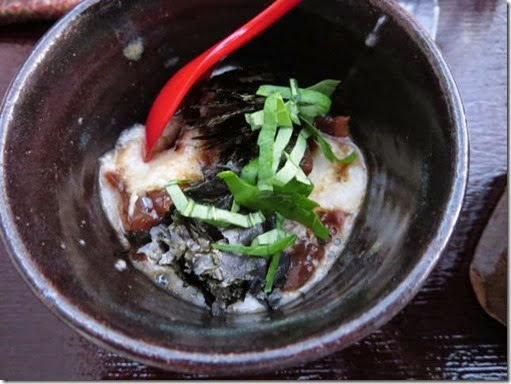
The 5th dish was our usual yamakake 山掛け (cubes of marinated tuna and graded nagaimo). Since we did not have perilla leaves, I used fresh basil leaves we had growing on the window sill. (I gave my wife the choice of fresh mint or basil leaves. She suggested basil). Unexpectedly, this combination was really good. I think we’ll use it again.
Although these were small dishes, we are getting quite filled up at this point. Since the day was so warm, we turned on the flood lights and went into night time cherry blossom gazing or “yozakura kenbutsu” 夜桜見物.

As you can see this one got caught “red beaked” as it were. Come to think of it their beaks are always red.

They only eat the bottom of the flowers which must contain a sweet nectar or something.

Amazingly, some of our squirrels appear to have learned from the birds. This is the first year we caught one eating the flower. As a result, even before full bloom, cherry petals were dropping.

In any case, we continued with our feast despite this distraction. This one is "Nanohana" (broccolini) and shrimp dressed in “kimisu” 菜の花と海老の黄身酢和え. “Kimisu” is a sort of Japanese hollandaise sauce without butter. I also added cucumber cup with tobiko roe on the side.
I got this idea when Chef Kitayama of Sushi taro served a dish with “kimisu” the last time we dined there. His was very rich and thick. He said he attained that texture by freezing the eggs in the shell. This makes it easier to completely remove the egg white (after thawing I assume) and also removes extra moisture from the yolk. I, of course, did not take this extra-step. Here is my recipe (the standard recipe but I did not measure the ingredients, the below is my estimate).
“Kimisu” 黄身酢:
One egg yolk (I used pasteurized shell egg)
Sugar (1 tsp)
Salt (small pinch)
Sake and mirin (1 tsp each)
Rice vinegar (1 tsp)
I mixed everything in a small sauce pan, on the lowest flame. Using a silicon spatula, I continuously mixed until the sauce thickened. I moved the pan on and off the fire to prevent scrambling the eggs. Since I did not remove the chalaza completely from the yolk, it became white hard specks in the sauce. I used a fine mesh strainer to remove it. I placed it in a small sealable container and refrigerated until use.
“Nanohana” 菜の花: I have posted information about flowering rapeseed plants and possible substitutes in the U.S. The substitute is between broccolini and broccoli rabe. I used broccolini for this dish. I just blanched it in salted boiling water for a few minutes and shocked it in ice cold water and drained.
Shrimp: These were shell-on frozen shrimp. I thawed them under running water. I rather severely salted it and let it stand for a while. I then cooked them in gently simmering salted water splashed with sake for few minutes, let them cool in the shell and then peeled the shell.
Although the sauce was not as rich or thick as Chef Kitayama's it was rather luxurious with some tang and sweetness gently wrapped in. A perfect, subtle spring dish.

The 3rd dish was usual “dashi maki” 出し巻き Japanese omelet. I served it with grated daikon and soy sauce on the side.

We switched the sake glasses . These came from Kitaichi glass 北一グラス in Otaru 小樽. Left is with sake in it, the right is without sake. Once the glass is filled with liquid, the cherry blossom pattern around the base appear to float up but it is not easy to capture this in a photograph. In any case, these were more appropriate glasses for the occasion.

The 4th dish was Wakatake-ni 若竹煮. Although it is the season for bamboo shoots and fresh wakame seaweed in Japan, we could not get these seasonal items around here. I used packaged boiled bamboo shoot (I am sure from the last year crop) and salt preserved wakame sea weed (which was kept frozen in the freezer).

The 5th dish was our usual yamakake 山掛け (cubes of marinated tuna and graded nagaimo). Since we did not have perilla leaves, I used fresh basil leaves we had growing on the window sill. (I gave my wife the choice of fresh mint or basil leaves. She suggested basil). Unexpectedly, this combination was really good. I think we’ll use it again.
Although these were small dishes, we are getting quite filled up at this point. Since the day was so warm, we turned on the flood lights and went into night time cherry blossom gazing or “yozakura kenbutsu” 夜桜見物.
Wednesday, October 28, 2009
Braised burdock root きんぴらごぼう
This is a very homey dish that you can only have in an Izakaya or at home but not in a fancy restaurant. It goes well with a glass of cold sake or with white rice. The root vegetable used here may not be very familiar in the U.S. but it is very popular in Japan. It is called "gobo" 牛蒡 or burdoc root. It has lots of fibers and is believed to have some medicinal properties. It has a nice crunch and a nutty, distinctive flavor. Among the gobo recipes, this dish, "kinpira gobo" きんぴらゴボウ, is by far the most popular and also our favorite gobo dish. "Kinpira", allegedly, is named after the character "Sakata Kinpira" 坂田金平, who was said to be a very strong and brave worrier, as told in a traditional story telling with songs and music called "joururi" 浄瑠璃 in Edo time. It requires a certain preparation which is the most labor intensive part needed to make this dish. The burdock is rather ugly, very thin long (few feet long) dark brown root vegetable. It is available in most Japanese grocery stores.
First prepare a large bowl of cold water with a small amount of vinegar or lemon juice (acidulated water). Cut the "gobo" root into shorter segments, so that they will fit into your bowl with the acidulated water. Under running water, scrape off the brown skin using the back of your knife exposing the white underneath. Since it will discolor very quickly, place these segments in the acidulated water immediately after the skin is removed. Take out one segment at a time from the acidulated water, cut thin ovals by slicing it diagonally using a sharp heavy knife (the root is fibrous and hard). Spread them overlapping like a stack of cards and then julienne them into match sticks. Immediately put them back in the acidualted water and repeat the process until all are julienned. I usually soak julienned burdock root for 10-15 minutes in the acidulated water (the water will become dark grey), then I wash them in running water and drain. If needed, spread them on paper towels and blot dry. Meanwhile, I peel and cut 1-2 medium size carrots (the amount of carrots to the burdock root is totally up to you) in the same manner as the burdock root and set aside.
First prepare a large bowl of cold water with a small amount of vinegar or lemon juice (acidulated water). Cut the "gobo" root into shorter segments, so that they will fit into your bowl with the acidulated water. Under running water, scrape off the brown skin using the back of your knife exposing the white underneath. Since it will discolor very quickly, place these segments in the acidulated water immediately after the skin is removed. Take out one segment at a time from the acidulated water, cut thin ovals by slicing it diagonally using a sharp heavy knife (the root is fibrous and hard). Spread them overlapping like a stack of cards and then julienne them into match sticks. Immediately put them back in the acidualted water and repeat the process until all are julienned. I usually soak julienned burdock root for 10-15 minutes in the acidulated water (the water will become dark grey), then I wash them in running water and drain. If needed, spread them on paper towels and blot dry. Meanwhile, I peel and cut 1-2 medium size carrots (the amount of carrots to the burdock root is totally up to you) in the same manner as the burdock root and set aside.
In a large saute pan like the one shown below or a Chinese wok on a medium high flame, add 1 tbs of vegitable oil and 1 tsp of dark sesame oil. I add red pepper flakes to the oil (the amount is totally up to you). When the oil is hot, add the burdock root and saute for 1-2 minutes so that all is coated with oil. Add carrots and saute another minute or so. Most recipes use sugar and soy sauce which, to me, will make this dish too salty and too sweet. In stead, I use 3 tbs of mirin, 3 tbs of sake and 2 tsp of soy sauce (I add bit more soy sauce later) and braise (you need to keep the ingredients moving using, in my case, long bamboo kitchen chopsticks as seen below, until most of the liquid has evaporated (10 or more minutes). I taste and add a small amount of soy sauce toward the end if necessary. When the liquid is almost all gone, turn off the flame and mix in white sesame. This dish gets better after one day. Serve at room temperature with extra sesame on the top.
Saturday, May 22, 2010
Sushi Taro, Dupont Circle, Washington DC 寿司太郎
The Dupont Circle area has undergone significant change over the years and is now a very vibrant neighborhood with numerous good restaurants. It also was my wife's old stomping grounds. This Japanese restaurant, Sushi Taro, used to be your usual run-of-the mill sushi bar/ tempura place. It occupies the second floor of an unassuming brown square building at the corner of 17th and P, with a CVS Drug store on the ground level. Last year it went though a major renovation, when the old owner's son, Nobu Yamazaki (pictured below), took over. He transformed the place into a high-end Kaiseki and Omakase Japanese restaurant. We went to the old Sushi Taro a few times and were not particularly impressed. It was a very ordinary sushi bar. After this drastic transformation, however, we have been back three times; twice for sushi omakase and once for regular Kaiseki omakase.

(From Washington post)
This time we started off with home-made umeshu 梅酒 aperitif with green plum simmered in syrup or "kanroni" 青梅の甘露煮, a very nice refreshing start, which was followed by their signature appetizer Gomadofu 胡麻豆腐 topped with Maine sea urchin, real wasabi (every time wasabi was served, our chef grated a wasabi daikon root with a traditional sharkskin grater--the difference between this wasabi and the usual fake one from the tube was remarkable). Since it was in season, the next was Junsai ジュンサイ in sweet vinegar and yuzu 柚子. Junsai was very fresh with thick gelatinous layers. It matched perfectly with gentle sweet vinegar sauce highlighted with a bright yuzu flavor. (Masa showed us the fresh yuzu they had just received--the very small green kind). We then moved to a simmered dish; Hiryouzu 飛龍頭 and shrimp shinjou 海老しんじょう in yuba 湯葉 sauce. This was a nice comforting dish and well-prepared, if not spectacular. Next came a huge and fresh Pacific oyster (cut into three pieces) from Washington State, Japanese call it Iwagaki oyster 岩牡蛎, on the half shell with a lemon wedge and okinawan salt. This was so good (you may have noticed we are partial to raw oysters). It went so well with the sake we were drinking; a nice fresh ocean taste and, without any special sauce or seasoning, it lingered pleasantly in the mouth for a while. Again seasonality is important here. "Ayu" 鮎 is in season. Japanese, especially Kyotoites, are very fond of this small fresh water river fish and we had this fish quite a few times in Kyoto. The Ayu which had been marinated very delicately in soy sauce and sake 祐庵地 was served butterflied and grilled 鮎の開き祐庵焼き. I like this rendition much better than the customary "shioyaki"塩焼き or salt grilled, which is usually served on a bed of salt and pine needles. Somewhere between these dishes, we had assorted "Hassun" appetizers 八寸 with 8 small tasty morsels; kinome-miso dengaku 木の芽味噌田楽, "aburana" with yuzu-miso アブラナの柚子味噌和え, lightly marinated firefly squid 蛍イカの沖漬け, "tamago-dofu" 卵豆腐, a small savory egg custard square with edamame paste, salt-cured shirako 白子 with vinegard daikon strips, garlic sprouts 芽ニンニク with miso-marinated Manila clams. All were fantastic. The only slight disappointment being the dengaku due to the quality of the tofu which could have been better. The salt cured "Shirako" or cod sperm sac (which does not sound appetizing) was delicate and tasty.
 I just want to mention sakes we tasted at Sushi Taro on three occasions. The sake list is not extremely long but quite decent covering from the high-end to moderate. Among the ones we tasted; Muromachi Jidai 室町時代 (Junmai Supreme-Daigijo or Kiwami-daiginjo), Hakkaisan 八海山 (Ginjou), Kubota Hekiju 久保田 蒼寿 (Junmai Daiginjou), Dassai23 獺祭 (Junmai Daiginjo) and Hakuryu 白龍 (Daiginjo). By far, "Muromachi Jidai" is our favorite. Complex yet clean tasting and it is just cut above. Next will be Dassai23. Not as complex but very pleasant and clean. Hakkaisan is a bit too yeasty to our taste. Kubota has some muddy note and Hakuryu is rather simplistic.
I just want to mention sakes we tasted at Sushi Taro on three occasions. The sake list is not extremely long but quite decent covering from the high-end to moderate. Among the ones we tasted; Muromachi Jidai 室町時代 (Junmai Supreme-Daigijo or Kiwami-daiginjo), Hakkaisan 八海山 (Ginjou), Kubota Hekiju 久保田 蒼寿 (Junmai Daiginjou), Dassai23 獺祭 (Junmai Daiginjo) and Hakuryu 白龍 (Daiginjo). By far, "Muromachi Jidai" is our favorite. Complex yet clean tasting and it is just cut above. Next will be Dassai23. Not as complex but very pleasant and clean. Hakkaisan is a bit too yeasty to our taste. Kubota has some muddy note and Hakuryu is rather simplistic.
Sushi omakase takes place in a room, separated from the main dining area, with a light-colored wood counter which only seats 6, Nobu himself and Chef de cuisin Masa Kitayama are behind the counter, where the cooking area is rather large with a charcoal burning Konro grill (exactly the same as the one we have) in the back counter in front of a picture window overlooking a stand of bamboo. The setting is very similar to a high-end sushi bar in Japan as described by Jon. The atmosphere is very intimate and quiet. With capacity for only six customers, the customers have the complete attention of the chefs. The night we were there only 4 customers, including ourselves, were in attendance. This time we feasted for over 3 hours with 12 courses--and this is not counting each individual piece of sashimi and sushi. This feast was much more than sushi and sashimi omakase as you will see.
This time we started off with home-made umeshu 梅酒 aperitif with green plum simmered in syrup or "kanroni" 青梅の甘露煮, a very nice refreshing start, which was followed by their signature appetizer Gomadofu 胡麻豆腐 topped with Maine sea urchin, real wasabi (every time wasabi was served, our chef grated a wasabi daikon root with a traditional sharkskin grater--the difference between this wasabi and the usual fake one from the tube was remarkable). Since it was in season, the next was Junsai ジュンサイ in sweet vinegar and yuzu 柚子. Junsai was very fresh with thick gelatinous layers. It matched perfectly with gentle sweet vinegar sauce highlighted with a bright yuzu flavor. (Masa showed us the fresh yuzu they had just received--the very small green kind). We then moved to a simmered dish; Hiryouzu 飛龍頭 and shrimp shinjou 海老しんじょう in yuba 湯葉 sauce. This was a nice comforting dish and well-prepared, if not spectacular. Next came a huge and fresh Pacific oyster (cut into three pieces) from Washington State, Japanese call it Iwagaki oyster 岩牡蛎, on the half shell with a lemon wedge and okinawan salt. This was so good (you may have noticed we are partial to raw oysters). It went so well with the sake we were drinking; a nice fresh ocean taste and, without any special sauce or seasoning, it lingered pleasantly in the mouth for a while. Again seasonality is important here. "Ayu" 鮎 is in season. Japanese, especially Kyotoites, are very fond of this small fresh water river fish and we had this fish quite a few times in Kyoto. The Ayu which had been marinated very delicately in soy sauce and sake 祐庵地 was served butterflied and grilled 鮎の開き祐庵焼き. I like this rendition much better than the customary "shioyaki"塩焼き or salt grilled, which is usually served on a bed of salt and pine needles. Somewhere between these dishes, we had assorted "Hassun" appetizers 八寸 with 8 small tasty morsels; kinome-miso dengaku 木の芽味噌田楽, "aburana" with yuzu-miso アブラナの柚子味噌和え, lightly marinated firefly squid 蛍イカの沖漬け, "tamago-dofu" 卵豆腐, a small savory egg custard square with edamame paste, salt-cured shirako 白子 with vinegard daikon strips, garlic sprouts 芽ニンニク with miso-marinated Manila clams. All were fantastic. The only slight disappointment being the dengaku due to the quality of the tofu which could have been better. The salt cured "Shirako" or cod sperm sac (which does not sound appetizing) was delicate and tasty.
At this point, we were presented with two choices; one was "Lobster" shabushabu and the other was a Japanese style snapping turtle soup スッポンのお吸い物. Without hesitation, we took the snapping turtle. This was quite a soup; mine had one of the legs and my wife's had nice meaty parts. The broth was very savory. Yet the shimmering liquid in the bowl did not completely cover up the underlying primordial reptilian taste suggestive of mysteriously lurking depths of the pond. This does not taste like a chicken for sure. Since I got the leg, I had to spit out the "nails" as I chowed down.
Since I made the reservation directly with Chef Masa and mentioned that the last time we were there we liked his home-made "Karasumi" からすみ, he gave us a small slice of that dreaded "Funazushi" フナ寿司 which was marinated with sake lee. Marinating in sake lee or "Sake kasu" 酒粕 made it very palatable (actually good). It had a similar texture and taste to "Karasumi". What a personal service!
Then, we were presented with several square lacquer boxes of today's sashimi items. One box was all "hikarimonoayu" offered as sashimi. We started with a series of sashimi, very small but carefully prepared pieces; tuna around this time of year was less fatty and firm but very tasty. Again, freshly grated wasabi was just so nice. We can not remember every pieces we had but other stand-outs are "sayori" or needle fish, "Ayu" served two ways (one as is-just salt cured, and the other mixed with salted and preserved ayu innards called "Uruka" うるか. Ayu innards are cherished for their slightly bitter taste. Uruka definitely added a salty and slight bitter taste but it was a nice combination of tastes. I can not forget the wild white salmon from Alaska. Very tasty. Oh, one more item worth mentioning is, again in season, bonito "katsuo" 鰹 which was lightly grilled on a charcoal fire (Tataki) and served in a separate bowl with grated garlic and ginger; nice meaty slices and very flavourful. I have eaten a great deal of sashimi in my day but somehow this was especially good. Between the sashimi and sushi course we were offered a small delicately done "Sayori tempura" with perilla leaves さよりの天ぷら. At this point we were so full it was an effort to finish the sushi. Masa responded by making the rice ball very small for us and we had 4-5 pieces of yummy sushi.
Finally, we were presented with the desert menu. We picked a Japanese "purin" custard, "kurosatou" or dark sugar (from Okinawa) ice cream. Both were very good but we particularly liked the very delicate Japanese custard.
In summary, we really like this place. This is one of the best restaurants we have eaten at both here and in Japan. They serve very traditional carefully created food with a keen sense of seasonality ("Shun" 旬) and the sake selection is quite decent. The only problem for us (if you can even call it a problem for most people) is that we get so full by the end of the feast in both Sushi omakase and regular Kaiseki. It is a bit expensive but a similar class restaurant in Japan will certainly cost much more.
Monday, January 6, 2020
Shushi Taro Osechi 2020 寿司太郎のおせち重箱 2020
After this first round prelude, we finally opened the Sushi Taro Osechi Jubako 寿司太郎のおせち重箱. Although we have done this every new year since 2012, it is still always a thrill to open the osechi box. The picture below shows the first layer. We immediately notice our favorites "karasumi" 唐墨 and steamed sea urchin 蒸しうに. A new item we noticed (there may be more) is in a bamboo container on the right upper portion called "lobster in shuto egg sauce" ロブスターの酒盗和え (see the comments on our tasting of this item, below).
Here is the close-up of karasumi or Japanese Bottarga. They make their own at Sushi Taro and as far as we can tell, it is the best.
This is the second layer. In this layer one of our favorites is in the left upper corner which is "Monkfish liver terrine" or あん肝豆腐.
1. Karasumi, 2. Steamed sea urchin, 3. lobster in Shuto egg sauce*, 4. Caramelized baby shrimp, 5. Fish cake with matsutake mushroom, 6. Cod roe rolled in kelp, 7. Steamed kumquats in syrup, 8. Monkfish liver terrine and 9. Glazed duck.
*Lobster in Shuto egg sauce is new this year and we liked it very much. The sauce is creamy and I am wondering if it is like "kimi-su" 黄身酢 which was also seasoned with "Shutou" 酒盗 but that is my guess.
In any case, this was the excellent first evening feast of 2020.
Tuesday, October 18, 2011
Grilled Matsutake and Ginko nuts 焼き松茸と銀杏
This is the ultimate taste of autumn; grilled matsutake 松茸 and ginkgo nuts or "gin-nan" 銀杏. Of course real Japanese Mastutake cannot be had here in the U.S. and, even if available, it would be prohibitively expensive. Last year, I posted several dishes made with North American matsutake. We had the first matsutake of the year at Tako Grill and after that, I promptly ordered matsutake from Oregon Mushroom as I did last year. The price appears to be a bit higher this year but "cheap" compared to either Mexican or Japanese matsutake. The Mexican mushroom is closer in appearance to the Japanese kind and they fetch higher prices. The appearance and smell of the North American matsutake are not as good as the Japanese but the will do for us.
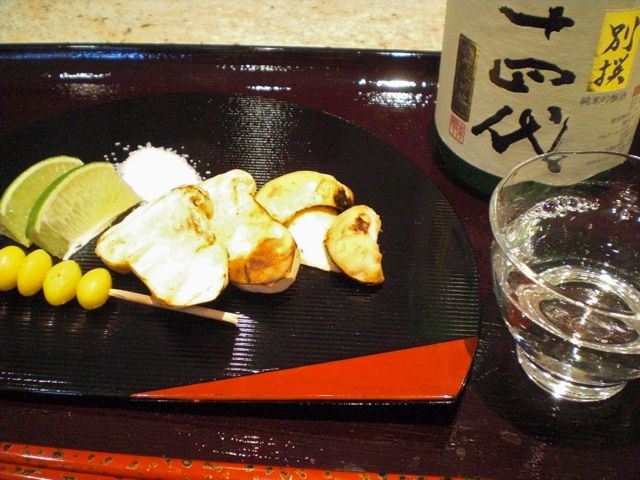
The simplest and the best way to enjoy matsutake is simply grilled and eaten with a squeeze of "kabosu" カボス citrus and salt. I also added grilled gingko nuts or "gin-nan" 銀杏 (I could have collected gingko fruit from gingko trees in our areas but the effort for preparation and not so pleasant smell of the fresh flesh of the fruit forced me to use a canned prepared gingko nuts instead). I served grilled matsutake and gingko nuts with small wedges of lime (since I did not have "kabosu" or "yuzu" 柚子 fruit, this is closest I can come) and salt. I opened a bottle of Juyondai sake 十四代 I had for this occasion (above). (I have one more left).
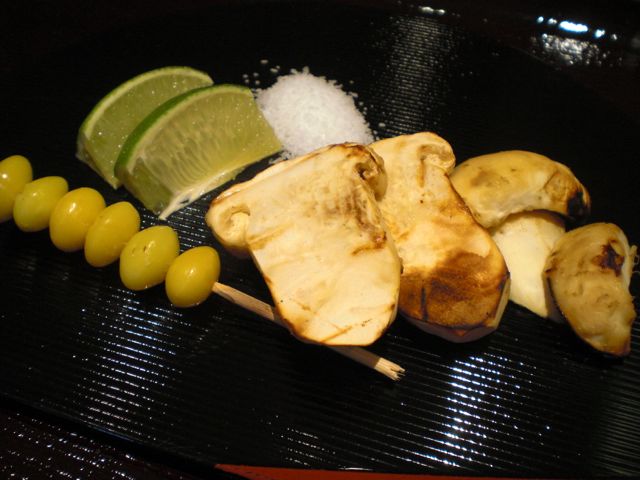
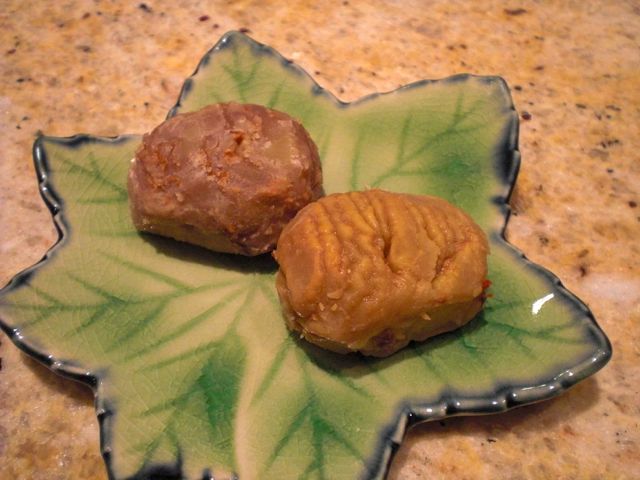
Matustake preparation: In the image #1 below, you see how dirty it was when I received it (#1 left). I first used a dump paper towel to remove the dirt but you need to use a sharp paring knife to scrape off embedded dirt (#1 right). You really have to make sure all the dirt and sands were removed (#2). I prepared special bamboo skewers by shaving regular bomb skewer into very thin skewers so that it will not break the gingko nuts when pierced (#2 shown with two cleaned matsutake).

To prevent the matustake from getting too dry while being grilled, I sprinkled sake over the sliced matsutake (sliced in 1/4 to 1/3 inch thick) and let it soak in for 3-4 minutes before grilling. Since I could not use a charcoal fire this time, I used a Japanese diffuser and a metal wire grill to grill directly over the gas fire (#4). I used a rather hot fire to make grill marks and also cook the matsutake quickly without drying it out (for 3-4 minutes or less). The gingko nuts only grilled for only 1-2 minutes but you have to be careful not to burn the skewers.
You can enjoy the subtle but distinctive smell and flavors of matsutake in its pure form. The combination of matsutake and gingko nuts is ultimate autumn flavors but I went further and also served boiled North American chest nuts (below) to complete the autumnal theme. Juyondai brewed from Yamada-nishiki 山田錦 was nicely fruity with subtle "umami" dimensions.
We throughly enjoyed the good sake and this autumnal collection of goodies and opening Juyondai was definitely worth it.
Subscribe to:
Posts (Atom)

















